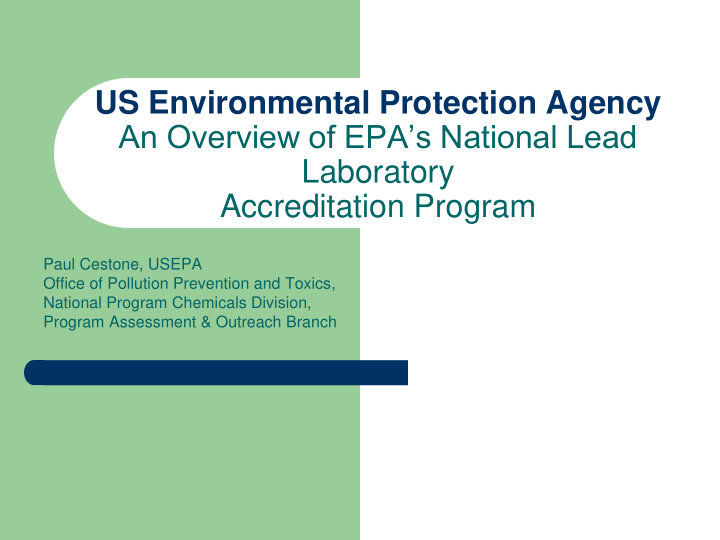



US Environmental Protection Agency An Overview of EPA’s National Lead Laboratory Accreditation Program Paul Cestone, USEPA Office of Pollution Prevention and Toxics, National Program Chemicals Division, Program Assessment & Outreach Branch
EPA’s National Lead Laboratory Accreditation Program (NLLAP) TSCA § 405(b) directed EPA establish a program to certify laboratories as qualified to test substances for lead content. EPA established the National Lead Laboratory Accreditation Program (NLLAP) to recognize laboratories that demonstrate the ability to accurately analyze paint chip, dust, or soil samples for lead. Under NLLAP EPA developed the Laboratory Quality Systems Requirements (LQSR) in 1994 establishing protocols, criteria, and minimum performance standards for laboratory analysis. 2
EPA’s National Lead Laboratory Accreditation Program (NLLAP) - continued Fixed-site laboratories, mobile labs, or testing firms are all eligible to obtain EPA accreditation recognition through the NLLAP. The NLLAP LQSR was updated in 1996 and a second time in 2007 as LQSR, version 3.0 (LQSR3) LQSR3 reflects EPA NLLAP program updates and updates to ISO 17025. 3
Some Key Components of NLLAP LQSR 3.0 The LQSR3 includes: Provisions for lead laboratory analysis programs for – fixed labs and for field sampling measurement organizations (FSMOs) that use portable or field devices, such as XRFs Requirements for one person laboratories – Education/experience requirements for laboratory – personnel Guidance on quality control requirements – Performance requirements – Document control guidance – 4
NLLAP Accrediting Body Recognition EPA presently recognizes through Memorandum of Understandings (MOUs) three organizations as laboratory Accrediting Bodies (ABs): – American Industrial Hygiene Association (AIHA) – American Association for Laboratory Accreditation (A2LA) and – Perry Johnson Laboratory Accreditation, Inc. (PJLA) 5
EPA and The NELAC Institute MOU April 2010 EPA and The NELAC Institute (TNI) signed a MOU that recognizes TNI as an accrediting body collaborator, specifically for accrediting field sampling measurement organization (FSMO) ABs. The MOU recognized that TNI’s voluntary National Environmental Field Activities Program (NEFAP) is consistent with and meets the goals and standards of NLLAP and LQSR3 for evaluating and recognizing ABs that accredit FSMOs. 6
EPA and The NELAC Institute MOU – Continued The MOU established that TNI, through implementation of its NEFAP, is qualified to evaluate, recognize, and perform oversight of the FSMO ABs; and Established that TNI’s FSMO accreditation standards will be used by TNI-recognized FSMO ABs to assess and accredit FSMOs as qualified to test for lead in paint films, dust and soil samples collected and measured on-site using portable field testing technologies. 7
EPA / TNI Program Activities OPPT is a member of TNI’s Field Proficiency Testing (PT) Subcommittee. The PT Subcommittee will establish Fields of Proficiency Testing (FoPT) and performance evaluation material (PEM) standards for lead (Pb) in soil, paint films, and dust matrices for use by National Environmental Field Activities Program (NEFAP). Once the FoPT for the three matrices are established, the subcommittee will continue to develop standards for PEM production. The goal is to have the FoPT and PEM production standards established by the end of 2010 and PEMs available for FSMO accreditation through ABs by early 2011. The specifics of the FoPT standards development will be discussed in the next presentation. 8
For More Information: Erik Winchester Associate Chief, Program Assessment & Outreach Branch (202) 564-6450 winchester.erik@epa.gov or Paul Cestone Program Assessment & Outreach Branch (202) 566-0489 cestone.paul@epa.gov National Program Chemicals Division Office of Pollution Prevention & Toxics US EPA Washington, DC 20460 9
Recommend
More recommend